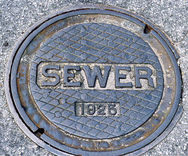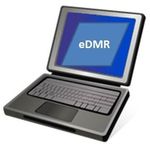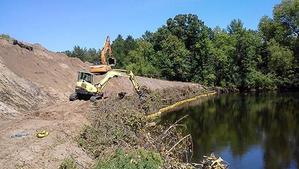|
January 2018

Inflow and infiltration were once big problems for the small
town of Good Thunder in Blue
Earth County in southern Minnesota. By being persistent and working as a team, city
councilors and staff were able to take advantage of opportunities and detect
major sources of I & I.
The town of 583 people has a pond system designed to treat
an average of 50,000 gallons per day (gpd) of wastewater, and up to 85,000 gpd
during wet weather. But a large rain event or spring thaw would result in
300,000 gpd going through the system. That meant many discharges to the Maple
River during the spring and fall to keep up with the overload. It also meant
extra expenses for Good Thunder and a lot of worry for Brian Severns,
wastewater operator for the town.
In the last year, Good Thunder has decreased its influent
flow by more than half, saving the town money through:
- Less water flowing through the drinking water
and wastewater treatment systems
- Fewer hours of staff time managing the system
- Less need for pumping, meaning reduced wear on
equipment and lower electrical costs
- Avoiding the cost of buying land and building a
new pond to accommodate the hydraulic overload
“It saves me a lot of worry at night,” Severns added with a
laugh.
The town took a multi-faceted approach to solving the
problem.
When the state of Minnesota reconstructed Highway 66 that
runs along the eastern edge of Good Thunder, it recommended replacing or lining
the town’s sewer main. The town chose lining and that stopped the major source
of I & I to the pond system.
Good Thunder also worked with the Minnesota Rural Water Association to look for
leaks in its drinking water lines. It found many small and one big residential leaks
that, once corrected, dramatically dropped the amount of water being treated
and pumped for drinking as well as the water flowing to the wastewater system
for treatment.
In addition, the town inspected sump pump systems,
contracted a company to inspect the sewer lines with cameras, and educated
residents and businesses on I & I issues through newsletters and utility
bill messages.
“Even though we got the big stuff, we’re going after the
little stuff,” Severns said.
Instead of discharging the ponds twice in the spring and
three times in the fall, he is hoping that drops to one per spring and
per fall. That’s good news for the river too because a longer retention time
means a bigger reduction in phosphorus levels in the discharges.
Severns has sound advice for other cities tackling I & I
problems:
- Provide the city council with a visualization of
the data behind the problem. Using an Excel spreadsheet, Severns tracked
rainfall, drinking water pumped from the town’s well, and water influent to the
wastewater system. He then provided a
bar graph of the data to the city council every month so it could visualize the
problem and see progress with each step taken.
- Educate residents and businesses on the
importance of I & I.
- Use cameras to look for leaks in pipes.
- Take a team approach with the city council and
maintenance staff. Severns credits Good Thunder’s maintenance worker, Brian Beckel, with doing much of the work.
- Take advantage of Minnesota Rural Water Association resources.
Severns called this association “essential” to the problem-solving.
“Patience is a virtue because sometimes it takes a lot of
detective work to fix. By doing due diligence, you’ll figure it out,” he said.
|

The 20-year projected need for wastewater
infrastructure throughout Minnesota is almost $5 billion, up from $4.2 billion
two years earlier, according to a community survey.
State law requires the Minnesota Pollution
Control Agency (MPCA) to conduct a community Wastewater Infrastructure
Needs Survey (WINS) every 2 years. The agency received responses from 715
communities in June 2017, and the resulting data and full report can be found on the MPCA website.
The $4.99 billion includes:
-
$2.9
billion (58%) to fix aging
and inadequate piping and pumping systems
- $1.3 billion (26%)
to maintain and upgrade treatment systems to meet minimum water quality requirements
- $225 million (5%)
to upgrade treatment systems to meet advanced water quality requirements
- $522 million (10%)
for new piping and pumping systems, such as for municipal growth
-
$51.5 million (1%)
for undefined projects
Key points from the data include:
-
The
need for sewer system rehabilitation and upgrade ($3.43 billion) is much greater than wastewater treatment infrastructure work ($1.57 billion).
- The age of sewer and
wastewater treatment infrastructure continues to be a significant issue. A high
percentage of sewer and wastewater treatment systems are near the limit of
their expected useful life.
- In greater Minnesota,
20% of the treatment facilities are more than 40 years old and 32% of the sewer
systems are more than 50 years old.
- Small communities more
frequently struggle with affordability of infrastructure improvements. In the
most recent survey, 19% of communities with populations less than 1,500
reported unaffordable wastewater costs.
The next WINS survey will be sent
electronically to communities in the spring of 2019, and the data will be used
to complete the 2020 WINS Report. If you have any questions about the WINS
Report or data, please contact Cara Omana of the MPCA at cara.omana@state.mn.us or 651-757-2891.
|
State agencies are now
accepting submissions to place public wastewater, stormwater, and drinking
water infrastructure improvement projects on the 2019 Project Priority Lists
(PPL) and Intended Use Plans (IUP) for Clean Water and Drinking Water State
Revolving Funds. Projects must be listed on the appropriate PPL as the first
step to be eligible for funds.
System owners must
request that their projects be placed on the appropriate 2019 IUP if they
expect to be ready for construction and are seeking revolving funds for fiscal
year 2019 (July 1, 2018 to June 30, 2019).
The two state revolving
fund programs are administered by the Minnesota Public Facilities Authority (PFA), with the MPCA and
Minnesota Department of Health (MDH). The PFA provides low-interest loans or
grants to local governments for eligible projects based on priorities
determined by the MPCA (for wastewater and stormwater projects) and MDH (for
drinking water projects).
For more information and
instructions, please see this online
document or contact one of the agency staff below.
Project
Priority List – Clean Water Revolving Fund
- Wastewater and stormwater projects
- Deadline: March 2 to MPCA
- PPL application and scoring worksheet (including supporting documentation, as required)
- Wastewater facilities plans
- Stormwater project plans
- Contact: Bill Dunn, MPCA, at 651-757-2324 or bill.dunn@state.mn.us
- More information: www.pca.state.mn.us/ppl
Project
Priority List – Drinking Water Revolving Fund
Intended
Use Plans – both programs
- Specify which program on submission
- Deadline: June 1 to Public Facilities Authority
- Contact: Becky Sabie, PFA, at 651-259-7470 or rebecca.sabie@state.mn.us
- More information: mn.gov/deed/pfa
Asset management is key to utilities
making sound decisions and ensuring the long-term sustainability of their water
and wastewater systems. To help utility managers, especially those working for
small communities, the Minnesota Rural Water
Association (MRWA) has developed asset management tools and training,
available at no charge to members.
As the association
explains on its website: Water and wastewater systems are made up of assets.
Some of these assets are buried and are "invisible" while others are
visible. Wastewater system assets include ponds, mechanical plants, pumps, lift
stations, valves, collection lines, force mains, manholes and any other
components that are necessary to operate the wastewater system. As a system
ages and deteriorates, the assets will lose value over time. As this happens,
the level of service that the utility's customers desire may become
compromised, operation and maintenance costs can increase and the utility may
have extreme costs that it can't afford. Asset management is a method of
managing the utility's assets. Asset management will assist the utility with
making good decisions on caring for the aging assets.
The association has
developed Excel templates that utilities can download and use at no charge.
Visit the MRWA website for the
templates and information on how to use them.
The MRWA also offers hands-on training that includes
the core components of asset management and how to use association’s templates.
For more information, contact the association at 800-367-6792
or mrwa@mrwa.com.

An administrative law judge recently rejected the MPCA’s
proposed changes
to the standard to protect wild rice. The existing rule (or standard)
limits sulfate to 10 milligrams per liter in water used for the production of
wild rice. However, the MPCA’s new research indicates that sulfide – converted
from sulfate by bacteria - in the sediment
in which wild rice grows is the pollutant of concern. The proposed rules are
designed to limit sulfide to 120 micrograms per liter. The proposed
changes would have established a process to identify the level of sulfate that
would be protective for each wild rice water body. The proposal would have also
identified wild rice waters in Minnesota.
The MPCA is now evaluating all available options following
the ruling.
“While we are disappointed with the ALJ
disapprovals in the report, we are pleased that the ALJ agreed the proposed
revisions were based on sound scientific evidence,” the agency said in a
statement issued to media.
“At the Legislature’s direction, the MPCA worked diligently
for nearly seven years to craft a modern, workable rule that would protect wild
rice from the impacts of sulfate pollution. We strongly believe that those
efforts delivered a solution that would effectively protect this important
resource, while providing a workable standard for businesses and industries
that would be impacted by these regulations.
“Significant input, including 4,500 public comments received
through a 93-day open public comment period and six public hearings, informed
numerous appropriate adjustments to the proposed rule revision.
“In light of the ALJ report, MPCA now intends to proceed
with the rule revision process, as prescribed by Minnesota state law. We will
first submit a comprehensive written response to the ALJ report. The Chief ALJ
will then review our response and determine if the modified proposal is
acceptable. We believe this exchange can lead all parties to a workable
solution, and we remain strongly committed to achieving that ideal outcome.
“The Minnesota Legislature shares a keen interest in this matter
and we look forward to working with legislators and the public as we continue
to refine an improved rule proposal.”
Related media coverage:
|

The MPCA is pleased to announce that Aaron Luckstein has
accepted the position of municipal wastewater section manager, previously held
by Wendy Turri, who is now the wastewater superintendent for the Rochester (Minn.)
Water Reclamation Plant.
Luckstein has served many roles within the MPCA wastewater
program since 2006, including wastewater inspector, permit writer, assistant pretreatment
coordinator, and supervisor. From 2012 to 2016, he served as the southeast regional
unit supervisor and most recently as the supervisor for the Industrial
Wastewater Quality Compliance and Enforcement Unit.
In his roles, Luckstein has become known as a consistently
calm and visionary leader with a commitment to staff development and program
growth by using continuous improvement strategies that create a solid
foundation; establishing Strategic, Measurable, Attainable, Relevant, and
Timely goals and objectives; developing clear implementation strategies, and providing
motivational support for the team.
He also places an emphasis on
developing effective professional relationships between the state, federal and
local governments, permit holders, public interest groups and Minnesotans.
In his free time, Luckstein enjoys
spending time with family and friends, fishing, and playing basketball. Like
many parents, he stays busy chauffeuring his kids to and from sporting
events and cheering them on in their sports.
He can be reached at aaron.luckstein@state.mn.us or
507-206-2606.
|
 All municipal and industrial
staff who are responsible for submitting eDMRs for their wastewater facility should
have his or her own eServices account. The MPCA recommends not sharing account numbers for liability purposes. See the “How to complete your discharge monitoring report”
webpage for “eDMR signup and submittal” information.
Additionally, if previously authorized individuals need to be removed from an account, please submit the "Request to Remove Account Holder" form on the MPCA website.
If you have other
questions about eDMRs, please consult your compliance
officer.
|
Annual report due dates should be on the radar of wastewater
treatment facilities. The MPCA requires permit holders to submit many types of
annual reports this time of year, including the following:
- Biosolids
- Pretreatment
- Industrial by-product
- Spray irrigation (municipal and industrial)
- Industrial stormwater (more information below)
Some
wastewater treatment facilities must submit an annual stormwater report. Check
your wastewater discharge permit for a stormwater chapter that includes
requirements for industrial stormwater. Part of those requirements may include filling out an industrial
stormwater annual report. Along with publishing this reminder in On Point, the
MPCA is emailing a notice to facilities with this requirement.
If
you need to submit a report, you can download and use the following forms:
Please
send your completed annual report via the U.S. Postal Service to:
WQ Submittal Center
Minnesota Pollution Control
Agency
520 Lafayette Road
St. Paul, Minnesota 55155-4194
The
due date for stormwater reports varies by facility and can be found in permits.
If
you have questions about any annual reports, please check your permit or contact
your compliance
officer.
NPDES/SDS permit holders should be receiving the draft
version of the Annual Compliance Summary Report, also known as the “Big Report.”
Due to issues with the MPCA’s database system, not all draft reports were
emailed to permit holders in December, so the agency will continue mailing them
through Jan. 26. The drafts are going to the authorized signers for eDMRs. If
you do not receive a draft by Jan. 29, please contact the MPCA for a draft via an
email to npdes.pca@state.mn.us.
The system glitch also means some permit holders may receive
multiple copies by email. They should all contain the same data so you can delete
the duplicates.
The drafts provide permit holders the opportunity to review
the information in the MPCA’s database regarding their NPDES/SDS permit for Oct.
1, 2016 through Sept. 30, 2017. If
prompt corrections are sent to MPCA after receipt of the draft version, the
updates should be reflected in the final version of the Big Report that is sent
to the authorized signer(s) and the responsible official for the facility. The
MPCA plans to send the final version in spring 2018.
To ensure delivery of the Annual Compliance Summary Report
and avoid diversion to the junk mail folder, please add npdes.pca@state.mn.us
to your address book now.
The 2018 MPCA Wastewater
Operator Training Calendar and registration form is now available on the MPCA
Wastewater Training website: www.pca.state.mn.us/water/training-wastewater-operators.
The MPCA will hold the 44th
annual Collection System Conference March 19-21 at the Marriott
Northwest in Brooklyn Park (7025 Northland Drive North, Brooklyn Park,
Minn.).
Highlights include:
- SA and
SB exam refresher
- SC and
SD exam refresher
- Certification
examinations
- Vendor
and professional organization displays
Other topics include inspection
techniques and tools, pipe and manhole rehab, asset management, pumps and lift
station tour, electrical generation and controls, infiltration and inflow,
condition assessment, odor control and biofilters, working alongside your
coworkers, and much more. The conference brochure and registration packet is available
on the MPCA
wastewater training webpage. Exam refreshers
require pre-registration; see the registration page of the brochure for
details. For more information, contact Annaliza Heesch at 651-757-2591 or annaliza.heesch@state.mn.us.
The MPCA will hold the 81st
annual Wastewater Operations Conference March 21-23 at the Marriott
Northwest in Brooklyn Park (7025 Northland Drive North, Brooklyn Park,
Minn.).
Highlights include:
- A &
B exam refresher
- C &
D exam refresher
- Type IV
(biosolids) refresher
- Certification
examinations
- Vendor
and professional organization displays
- Facility
Operational Awards ceremony
Other topics include new plants
and upgrades, aging infrastructure and asset management, flooding challenges
and response, emerging issues, facility optimization, industrial wastewater and
pretreatment, treatment approaches for small wastewater utilities, stabilization
ponds, safety, new large subsurface treatment system policies and procedures,
and much more. The conference brochure and registration packet is available on
the MPCA wastewater
training webpage. Exam refreshers require
pre-registration; see the registration page of the brochure for details. For
more information, contact Annaliza Heesch at 651-757-2591 or annaliza.heesch@state.mn.us.
The MPCA is reviewing the compliance status of all eligible
wastewater facilities to determine Wastewater Facility Operations Award
recipients for 2017. There is no longer an application form to submit. You will
be contacted in February 2018 if your facility has qualified for an award. The
awards ceremony will be held during the annual Wastewater
Operations Conference March 21-23 at the Marriott Northwest in Brooklyn Park. Please contact your assigned compliance staff, or Kaitlin Jamieson (kaitlin.jamieson@state.mn.us or
651-757-2306) with any questions.
The Minnesota Public Facilities Authority (PFA) recently awarded
a $5.3 million grant for wastewater system improvements in East Grand Forks.
The funding, which was approved by the Minnesota Legislature in the 2017
bonding bill, will enable East Grand Forks to connect its wastewater system
with neighboring Grand Forks, N.D., and to decommission its wastewater
stabilization ponds. The PFA previously awarded the project a $6.9 million
loan.
Read more on the PFA website.
(Editor’s note: This is the second of a two-part series on water quality trading. The first part, in the December 2017 On Point, explained water quality trading and how it’s worked in Minnesota so far. This second part explains how water quality trading in Minnesota will be different under new standards and conditions.)
To date, Minnesota’s demand for water quality trading credits has been driven by dissolved oxygen and excess nutrient water quality objectives in the wastewater sector. But new standards and conditions will bring changes to water quality trading in Minnesota, as outlined below.

Stormwater trading
Regulated stormwater sources, such as cities with municipal permits, may also
seeking trading because urban best management practices (BMPs) can be much more
expensive than farming or other BMPs. Cities may be able to meet TMDL
requirements through non-point trades or offsets to reduce sediment, phosphorus
or even bacteria. (Photo at right shows a streambank restoration project for wastewater treatment credit.)
Anti-degradation trading
Pollutant reduction credits may be used to offset increased pollutant loads
resulting from the construction and operation of new or expanded wastewater or
stormwater discharges. Minnesota’s antidegradation regulations specifically
allow for a “loading offset” as a prudent and feasible alternative to avoid net
increases in loading or other cause of degradation (Minn. R. Ch. 7050.028 Subp.
2).
Impact of River
Eutrophication Standards (RES)
All trading activity must occur upstream of
the waterbody of concern in order to achieve water quality objectives. Existing
trading relationships that have been developed to address remote water quality
concerns may be disrupted if new water quality assessments result in the
designation of relevant water quality targets between an upstream buyer and a
downstream seller. Impacted relationships may include Lake Pepin’s excess
nutrients or the Lower Minnesota River low dissolved oxygen impairments. An
example of this situation is the current Minnesota River Basin General
Phosphorus permit trading relationship between a buyer in the Redwood River
watershed and a seller in the Middle Minnesota River watershed. The
longstanding trading relationship is intended to benefit the dissolved oxygen
impairment of the Lower Minnesota River. However, the MPCA listed the outlet
reach of the Redwood River in 2016 as impaired for excess nutrients. So now the
buyer will need to reduce phosphorus loading within the Redwood River watershed, either by reducing effluent
loading or through trading or a combination of the two. Because the phosphorus
reductions required within the Redwood River watershed are sufficient to
satisfy the reductions requirements for the Lower Minnesota River, it is
unlikely that the existing trading relationship will continue in the future.
Contact
For
more information about water quality trading, contact Marco Graziani at the
MPCA at 651-757- 2398 or marco.graziani@state.mn.us.
|
|